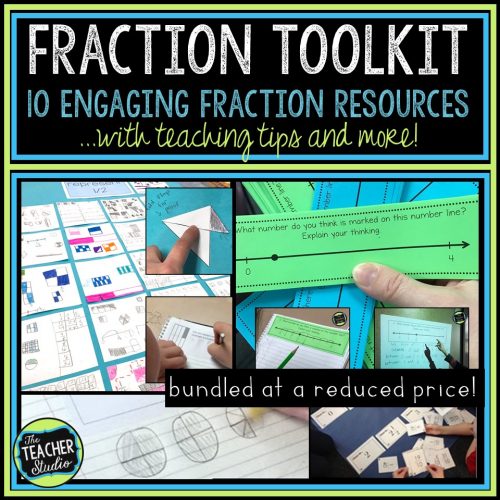Well, things got even more interesting as my work with fractions unfolded on day 2! For those of you who read my first fraction post, I discussed how we used paper folding to get our fraction concepts unit “launched”, and we ran out of time to finish the investigation before digging into some fraction misconceptions. I gave them another 25 minutes today to work on folding their different fractional amounts and then asked them to spend some time writing in their math notebook on any of the following:
What did you notice?
Was there anything challenging?
What was easy?
| Not a great photo…not great handwriting…sorry! |
Math vocabulary and language
What really stood out to me was the very NEBULOUS (vocabulary word!) math language I was hearing. A phrase that kept coming up was “small fractions” as in “It was harder to fold the small fractions.”
So, being the pesky and annoying teacher that I am, I presented this question to the class:
| Tee hee…I love to ask questions like this! |
So, I didn’t let the students talk . . . I just said that I was hearing MANY students use this phrase, so I thought we had better make sure we all knew what it meant. I asked each student to write the So, answer to that question on a post it note and come slap it on the easel.
 |
|
Being the obedient students that they are, they did.
|
And–seriously–I only wish I had taken some photos of the notes up close. SERIOUSLY! I had everything from . . .
64
to
1/100th
to
“When you make it smaller”
to
“Small fractions are like tenths”
At this point, any concerns I had about backing up this far and moving this slowly were GONE! I read off the notes to the students and then asked what we had learned about what a “small” fraction is and one of my delightful yet very shy students called out, “ABsolutely nothing!” and we all laughed hysterically.
What next?
So where do we go from here? I reminded the students about how we have been talking about the Common Core and how important it is to use precise mathematical language. I asked if “small fraction” was precise enough that anyone else would know what we meant. . . and we had complete agreement that it was not. Next, I asked them if, on our 4, 3, 2 , 1 rubric we were evaluate how clearly we communicated, we agreed that all our post its were 1’s with a few 2’s sprinkled in . . . until “T” asked, “If there really isn’t an answer, how could someone get a 4 on this?” Have I mentioned how much I love fourth graders? He honestly asked–and honestly wanted to know! I told him I had to think about it. . . always a good strategy for the tricky questions! Don’t answer too soon!
Deep fractional thinking
So I set the students to work on a little activity to set them up for tomorrow’s lesson…I asked them to work completely alone to answer the following question:
| If it is too small to read, the question asks “Is this shape divided into fourths? Explain your thinking.” |
I let them work for a few minutes and then on their way out to recess made them commit to either a “yes” or a “no” response . . . and it will be our kickoff “debate” tomorrow! Remember, one key element of the Standards for Mathematical Practice is the ability to explain one’s own work and to critique the reasoning of others . . . so tune in tomorrow to see how it all shakes out!
After they worked for a few minutes we gathered back together to talk about T’s question . . . is it possible to get a 4 on a question with no answer? Maybe I should save that for another blog post . . . this one is already plenty long–but I told him that yes, I do believe you can get a 4 on a question with no answer. I reminded him that we are stressing explaining our thinking, and we could certainly do that with this question. I modeled something sort of like this (this was done aloud, not in writing . . . I’m just trying to give you the gist of it)
“I know that there are different ways to look at the idea of being small. Some people might think the numbers should be small–like in 1/2. Some people might look at the size of the pieces to determine what a “small” fraction is. Still others might think a small fraction is one where you only look at one piece of a whole–like 1/3 is small where 2/3 is big. So for the question “What is a small fraction?”, it is very important to understand that there might be more than one way to answer it.”
Reasonable and rigorous expectations
 Would I expect a fourth grader to be able to answer like this? Maybe not today . . . but now that it has been modeled–perhaps. We must push their thinking, push their comfort level, and push them into the rigor that is required. If we make it meaningful, they can do it! Thanks for sticking with me again–sorry these are getting so long! Stay tuned to see how our debate works out . . . I’ll give you a hint–the vote was 9 “yes” to 13 “no”!
Would I expect a fourth grader to be able to answer like this? Maybe not today . . . but now that it has been modeled–perhaps. We must push their thinking, push their comfort level, and push them into the rigor that is required. If we make it meaningful, they can do it! Thanks for sticking with me again–sorry these are getting so long! Stay tuned to see how our debate works out . . . I’ll give you a hint–the vote was 9 “yes” to 13 “no”!
***UPDATE***
This blog post is now a part of my comprehensive fraction unit available by clicking the image below. Hundreds of teachers have now used it to change the way they teach fractions!
Now available as a part of a ten-resource fraction toolbox that might help you teach to deep understanding.







